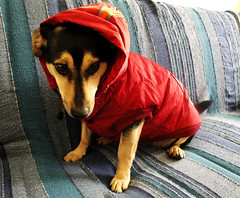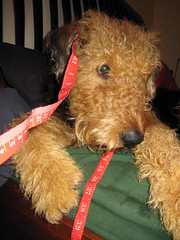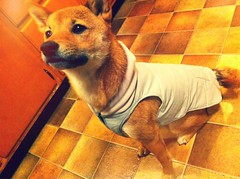Despite the recent mild weather I am already scouring the closets in my house for Barret’s winter wardrobe. With the growing potential for snow on the ground and the little guy’s reluctance to step past the front door these days, i guess it is time to find the dog jackets and coats. Many people think that since dogs have a fur coat, that they don’t need any additional winter gear. This is true for some dog breeds, but others, like Barret, have very thin, short coats and appreciate the extra layer of warmth when braving the great outdoors.
 I know a lot of people that think I dress him up just for fun, and that is only partially true. While it is fun for me to parade him around in stylish duds, it serves a very important purpose. The extra layers can be comforting to a dog that is particularly sensitive to cold weather. Dogs like Barret need the warmth of a coat, like a child venturing out in winter to play, to keep their temp up and their immune system strong. The extra layers help to conserve body heat, so your dog doesn’t have to work as hard to stay warm when outside, or even when hanging around the house.
I know a lot of people that think I dress him up just for fun, and that is only partially true. While it is fun for me to parade him around in stylish duds, it serves a very important purpose. The extra layers can be comforting to a dog that is particularly sensitive to cold weather. Dogs like Barret need the warmth of a coat, like a child venturing out in winter to play, to keep their temp up and their immune system strong. The extra layers help to conserve body heat, so your dog doesn’t have to work as hard to stay warm when outside, or even when hanging around the house.
Older dogs, dogs with thick coats that are clipped short, dogs that have diseases that impact hair growth and dogs with weakened immune systems should also wear jackets or sweaters when braving the cold outdoors.
 Double coated dogs or dogs with thick fur, like Huskies, can actually overheat if you put clothing on them. Their fur was genetically designed to retain heat in cold conditions, so they really do have a natural winter coat and don’t generally require any assistance.
Double coated dogs or dogs with thick fur, like Huskies, can actually overheat if you put clothing on them. Their fur was genetically designed to retain heat in cold conditions, so they really do have a natural winter coat and don’t generally require any assistance.
Finding the right winter gear
 If you won’t be bringing Fido along with you to shop, be sure to take measurements at home before you go. Measure the neck circumference, the length from collar to tail, and the circumference of the largest part of his chest. A great fitting sweater or jacket will be snug and form fitting, but loose enough to allow for everyday movement like sniffing, going the the bathroom and playing. Clothing items that are too loose may enable the dog to wriggle or walk out of the garment or get it snagged on something when he is playing.
If you won’t be bringing Fido along with you to shop, be sure to take measurements at home before you go. Measure the neck circumference, the length from collar to tail, and the circumference of the largest part of his chest. A great fitting sweater or jacket will be snug and form fitting, but loose enough to allow for everyday movement like sniffing, going the the bathroom and playing. Clothing items that are too loose may enable the dog to wriggle or walk out of the garment or get it snagged on something when he is playing.
Consider the ease of getting the garment on and off when looking at the fit. Some pull-over sweaters may be too tight to get over your pup’s head. I’ve found that garments with Velcro enclosures on the chest are the easiest to dress in and to get a good, snug fit with.
The material and color of the clothing should also be considered. How often you will need to wash it? How much will dirt show? If you have a dog that likes to roll in the mud, white might not be your best option. Knit sweaters can catch on ice and twigs and start to unravel. Wool may be the warmest, but it can also be very itchy. I personally like fleece jackets, or jackets with a fleece lining. It insulates well, washes without shrinking, and doesn’t easily get snagged.
Take time to acclimate
 If your dog isn’t used to wearing any clothing, just sticking him in a sweater and sending him off on his way might not work exactly planned. It may take a few days to acclimate your pet to his new coat. Using positive reinforcement, get your dog used to the idea of wearing a coat. Start by giving a treat every time you just hold the jacket. Once he is comfortable with the presence of the coat, gently drape it over his back and give him lots of treats and praise. Slowly work up to slipping his head through the neck hole and wearing the jacket entirely. Teaching “give me your paw… now the other one” beforehand can also make putting the jacket on a little bit easier.
If your dog isn’t used to wearing any clothing, just sticking him in a sweater and sending him off on his way might not work exactly planned. It may take a few days to acclimate your pet to his new coat. Using positive reinforcement, get your dog used to the idea of wearing a coat. Start by giving a treat every time you just hold the jacket. Once he is comfortable with the presence of the coat, gently drape it over his back and give him lots of treats and praise. Slowly work up to slipping his head through the neck hole and wearing the jacket entirely. Teaching “give me your paw… now the other one” beforehand can also make putting the jacket on a little bit easier.
The scoop on boots
 In recent years dog boots have come into the market. I thought these were kind of ridiculous at first; I mean, why would a dog need boots? Then I started to notice that we would stop frequently on our walks in the snow so they could lick their paws to remove the ice balls that would form between their pads. I also noticed that a lot of my neighbors were using salt on the sidewalks, and not necessarily the pet-safe varieties. I started to wipe off their paws after our walks to remove the salt. I think I might understand the need for dog boots now, and I might even give them a try this winter. I imagine that getting a dog used to wearing boots might be a prolonged process, but using positive reinforcement techniques anything is possible!
In recent years dog boots have come into the market. I thought these were kind of ridiculous at first; I mean, why would a dog need boots? Then I started to notice that we would stop frequently on our walks in the snow so they could lick their paws to remove the ice balls that would form between their pads. I also noticed that a lot of my neighbors were using salt on the sidewalks, and not necessarily the pet-safe varieties. I started to wipe off their paws after our walks to remove the salt. I think I might understand the need for dog boots now, and I might even give them a try this winter. I imagine that getting a dog used to wearing boots might be a prolonged process, but using positive reinforcement techniques anything is possible!
 That Pet Blog That Pet Place Pet Blog
That Pet Blog That Pet Place Pet Blog

Booties seem to be hit or miss with some dogs. My dog accepted them right away no problem. Ive seen some dogs that wont take them easily and need weeks of positive reinforcement to even keep them on. My cat has been working with socks for over 2 yrs and he actually went backwards. First he walked all criss crossed and shook feet constantly, now he wont even walk. He just stands there all awkwardly and refuses to move until i remove them.
Aww 🙂 Sometimes it is best to start slow with new things. What I did to get my dogs used to them is put one on and give treats and lots of praise, then take it off. I repeated a few times a day then gradually increase the number of boots we put on. Eventually he was very happy to see the boots! It took a few weeks, and he does walk in them like a dork, but he likes wearing them now and he doesn’t get ice stuck in his paws and limp when he goes out in the snow.